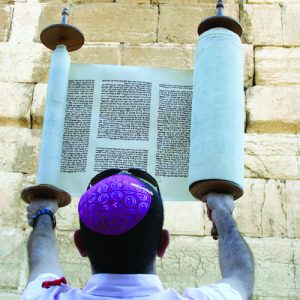
by: Nathan Williams, BFP Staff Writer
“Cover your head in order that the fear of heaven may be upon you” (Shabbat 156b).
 In the religiously, culturally and ethnically diverse regions of the Jewish Diaspora (the Jewish population outside Israel), kippot (plural of kippah) are often worn simply as outward symbols of Jewishness. On the other hand, Jewish sages teach that the real purpose of wearing a kippah is to bring the Almighty to remembrance. The external action of covering the crown creates an internal awareness, reinforcing the idea that God is always watching. The observance of this practice is a means to draw out one’s inner sense of respect for the Creator. Appropriately, the Yiddish word for the skullcap head covering, yarmulke, comes from the Aramaic, yira malka, which means “awe of the King.”
In the religiously, culturally and ethnically diverse regions of the Jewish Diaspora (the Jewish population outside Israel), kippot (plural of kippah) are often worn simply as outward symbols of Jewishness. On the other hand, Jewish sages teach that the real purpose of wearing a kippah is to bring the Almighty to remembrance. The external action of covering the crown creates an internal awareness, reinforcing the idea that God is always watching. The observance of this practice is a means to draw out one’s inner sense of respect for the Creator. Appropriately, the Yiddish word for the skullcap head covering, yarmulke, comes from the Aramaic, yira malka, which means “awe of the King.”
In Judaism the covering of one’s head is regarded as an act of devotion and humility. Due to the internal diversity of the Jewish people—owing largely to geographical and sectarian differences—kippot have taken on a multiplicity of appearances and meanings. Ultra-Orthodox Jews wear a kippah of black velvet that covers most of the head; traditional Jews wear a small black crocheted or knitted kippah; modern Orthodox mostly wear a smaller fabric or colorful crocheted kippot; Breslov Hasidim wear a white crocheted kippot; religious Zionists wear a crocheted kippot—and so the list goes on.
A man who wears a kippah is making a statement that he is a Torah (Gen.–Deut.) ambassador and his behavior while wearing this physical emblem, reflects on all Jews. Of course putting on a kippah does not automatically confer role model status, but its spiritual significance defines a Jewish man. The actions of someone wearing a kippah can create a Kiddush HaShem (sanctification of His name) or conversely a Chillul HaShem (desecration of His name). A Jew has to think twice before cutting in line at the bank or berating an incompetent waiter.
To wear a kippah is to proclaim pride in one’s Jewish identity. Yet the fact that it is the most recognizable mark of a Jew is affecting their religious freedom, which has caused some controversy in European Jewry. Harkening back to the days of the Nazi regime and the yellow Judenstern (Jewish star), many Jews are questioning whether their righteous desire to honor their religious custom is placing them into unwarranted danger.
The recent rise of anti-Semitism and attacks on Jews in Europe has led Jewish communal leaders, from Germany to Denmark, and France, to ask their community members to conceal their religious identity in public and not to wear identifying articles, including kippot. This call has led to an upheaval and a fierce debate on the Jews’ precarious status in Europe, only seven decades after the Holocaust. Presently one in four Jews in Europe is afraid of wearing Jewish symbols, like the kippah, in public due to rising anti-Semitism.
Although some religious leaders are warning Jews about the dangers of their religious garb leading to targeted victimization, both Jews and non-Jews alike are roundly condemning such prohibition as sending the wrong message. “We should not give an inch,” said France’s Chief Rabbi, Haim Korsia, after an attack in January on a Jewish teacher in Marseille. Korsia instead asked soccer fans to don a head covering at the next big soccer match in Marseille in camaraderie with the Jews of France.
Shortly afterwards an online campaign was launched using the Twitter hashtag #TousAvecUneKippa (“Everyone with a kippah“), calling on French people of all backgrounds to don the kippah and post a selfie on social media in a show of solidarity against anti-Semitic attacks. The initiators Sophie Taieb, who is Jewish and Kerima Mendes, who is not, said about the campaign “The idea is that everybody—Jewish or not—should wear a kippah, because if everybody wears one, nobody is a target anymore.” This campaign launched a global movement which trended on the social media site.
Later in the same month the Italian newspaper Il Foglio declared International Holocaust Remembrance Day as “Wear a Kippah Day” and distributed kippot to anyone who wished to wear one in public. In writing, “Let us all wear a kippah, why not?” Il Foglio explains that the rise of anti-Semitism in Europe is part of the surge of global Islamic terrorism, which must be combated if Christian Europe and the West do not wish to be vanquished and subdued by Islamist extremists.

Unlike the days during and after the Second World War, where the Jewish people had little to no option of escape from persecution, at present there is a nation standing with open arms to welcome back its dispersed people. This nation is Israel. For Jews wishing to evade the rising tide of anti-Jewish sentiment in Europe, their eyes are turning to their biblical homeland with great hope. “In Paris I would not dare wear my kippah outside of my home or synagogue,” says Oury Chouchana who recently made aliyah (immigration) to Israel from France, “but in Israel I feel so liberated to express my Jewish identity without fear of harassment.”
French Jews arriving in Israel are relieved to live in a country where they can express their Jewishness, and observe their religious customs without fear of reprisal. Israel is the safe haven for observant Jews in the current worldwide resurgence of anti-Semitism. The words from the biblical book of Esther come to mind—“for such a time as this.” The nation of Israel has been prepared for such a time as this. To welcome those of the Diaspora to come and be part of the fulfilment of God’s promises to give Israel a land in which to dwell safely.
Photo Credit: ChameleonsEye and Joshua Haviv/shutterstock.com
All logos and trademarks in this site are property of their respective owner. All other materials are property of Bridges for Peace. Copyright © 2025.
Website Site Design by J-Town Internet Services Ltd. - Based in Jerusalem and Serving the World.